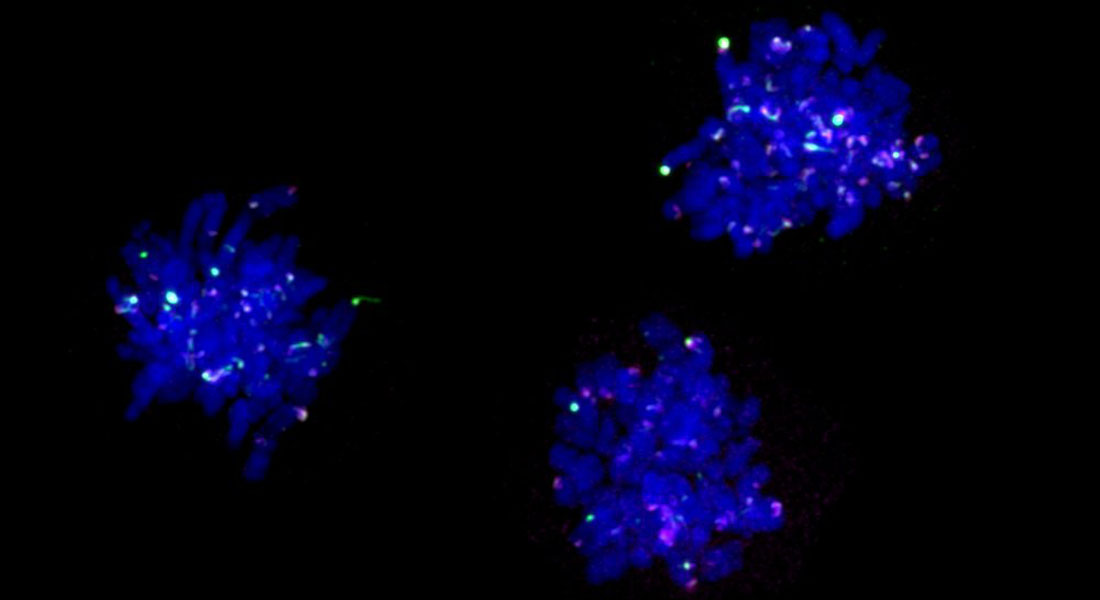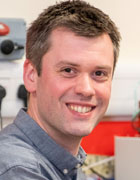Blackford Group
We study the signalling mechanisms cells use to respond to DNA damage and why defects in these pathways cause human diseases such as cancer.

Mutations caused by DNA damage enable a normal cell to become cancerous. This is highlighted by the fact that individuals with mutations in many genes involved in DNA damage recognition, signalling and repair are predisposed to cancer, and that somatically acquired defects in such genes can drive tumour formation. Furthermore, some of the most effective cancer treatments work in tumour cells by inducing DNA damage, particularly DNA double-strand breaks, which are especially toxic and difficult to repair accurately without introducing mutations. Exploiting knowledge of DNA double-strand break repair is therefore likely to lead to more effective and personalised cancer therapies and treatments for patients with DNA repair disorders in future.
The aim of our research is to gain a greater understanding of the signalling mechanisms cells use to coordinate DNA double-strand break recognition and repair with cell cycle checkpoint activation and apoptosis. To achieve this, we are using cutting-edge bioinformatics, proteomics, microscopy and CRISPR-Cas9 gene-editing techniques to answer specific questions related to DNA damage signalling. In doing so, we hope to provide novel insights into carcinogenesis and how it is held at bay by the cell’s DNA damage response system. We also aim to translate our research to develop novel potential cancer treatments. In particular, we are interested in the potential utility of signalling events for use as biomarkers and to identify novel targets in the DNA damage response for anti-cancer drugs.
- Protein-protein interaction networks in the DNA damage response
- Evolution of the DNA damage response
- DNA repair pathways in mitosis
- How RecQ helicases maintain genome stability
- Tsukada, K. et al. BLM and BRCA1-BARD1 coordinate complementary mechanisms of joint DNA molecule resolution. Molecular Cell 84, 1-19 (2024).
- Groelly, F. J. et al. Targeting DNA damage response pathways in cancer. Nature Reviews Cancer 23, 78–94 (2023).
- Zompit, M. D. M. et al. The CIP2A-TOPBP1 complex safeguards chromosomal stability during mitosis. Nature Communications 13, 4143 (2022).
- Hodson, C. et al. Mechanism of Bloom syndrome complex assembly required for double Holliday junction dissolution and genome stability. PNAS 119, e2109093119 (2022).
- Shorrocks, A.-M. K. et al. The Bloom syndrome complex senses RPA-coated single-stranded DNA to restart stalled replication forks. Nature Communications 12, 585 (2021).
- Blackford, A. N. & Stucki, M. How Cells Respond to DNA Breaks in Mitosis. Trends in Biochemical Sciences 45, 321–331 (2020).
- Leimbacher, P.-A. et al. MDC1 Interacts with TOPBP1 to Maintain Chromosomal Stability during Mitosis. Molecular Cell 74, 571-583.e8 (2019).
- Henssen, A. G. et al. PGBD5 promotes site-specific oncogenic mutations in human tumors. Nature Genetics 49, 1005–1014 (2017).
- Blackford, A. N. & Jackson, S. P. ATM, ATR, and DNA-PK: The Trinity at the Heart of the DNA Damage Response. Molecular Cell 66, 801–817 (2017).
- Harley, M. E. et al. TRAIP promotes DNA damage response during genome replication and is mutated in primordial dwarfism. Nature Genetics 48, 36–43 (2016).
- Blackford, A. N. et al. TopBP1 Interacts with BLM to Maintain Genome Stability but Is Dispensable for Preventing BLM Degradation. Molecular Cell 57, 1133–1141 (2015).
- Ochi, T., Blackford, A. N. et al. DNA repair. PAXX, a paralog of XRCC4 and XLF, interacts with Ku to promote DNA double-strand break repair. Science 347, 185–188 (2015).
We will soon be advertising to recruit postdoctoral researchers. Please contact Andrew Blackford (ablackford@sund.ku.dk) with your CV for further information if you are interested in joining our group.
Group Leader
 Andrew Blackford
Andrew Blackford
Associate Professor
ablackford@sund.ku.dk
(+45) 35 33 15 93
CV, publication, etc
